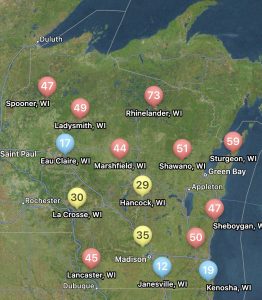Wisconsin Field Crops Disease Update, July 12, 2023
Damon Smith, Extension Field Crops Pathologist, Department of Plant Pathology, University of Wisconsin-Madison
Here is southern Wisconsin we are finally getting some rains. These rains are appreciated and timely for the crops out there, but also timely for some important pathogens of wheat, corn, and soybeans. Let’s talk about where we are at with disease risk this week.
What’s up with Wheat?
Let’s talk first about wheat first. Folks have started harvesting the crop and bailing straw and I have been getting photos of sooty mold on heads. You can find out more about sooty molds on wheat by clicking here. Essentially sooty mold is caused by a number of opportunistic fungi that can come in and cause mostly aesthetic problems on wheat heads that might have matured early, died early, or had other stress. These fungi do not need to be controlled. However, you should harvest affected wheat as soon as possible. Occasionally if wheat with sooty mold is left in the field for a long time, these fungi can eventually find their way in to the kernel and cause a problem called black point which can lead to quality problems. Get out and get that crop in as fast as you can!
Should I be Spraying for Tar Spot?

Figure 1. A Screen shot of a map developed in the Field Prophet app showing risk for tar spot development in Wisconsin as of July 12, 2023.
The short answer is not yet! Be patient. Yes, there have been many recent confirmations of the disease across the Midwest. You can find the most recent updates on tar spot confirmations here: https://corn.ipmpipe.org/tarspot/. Tarspotter is also showing mostly high risk across the state (Fig. 1). This means you should get out and scout! Remember, the best time to spray fungicide for tar spot is between the VT and R3 growth stages. We are not quite there yet and need to be patient to maximize the performance of our fungicides. You can learn more about managing tar spot by clicking here. If you think you found tar spot I would appreciate if you would let us know. We can enter the county level data into the Corn IPMPipe Map and contribute to the cause. Again, be patient and get out there and scout and get your steps in!
What to Do About Soybean White Mold?

Figure 2. Sporecaster predictions for selected non-irrigated locations in Wisconsin for July 12, 2023.
Yeah, it’s bean dry, yeah soybeans are slow to canopy. If you didn’t plant soybeans in narrow rows, you need to be patient and let soybeans get to full canopy. If this happens before the R3 growth stage, then check Sporecaster and see what the risk is. As of today, risk is low to moderate in south and south-central Wisconsin, Southwest Wisconsin, while in east and northeast Wisconsin risk is high if soybeans are flowering and canopy is nearly closed (Fig. 2). Again, I know it has been dry, but we are getting some timely rains that are impacting risk and resulting in the increase in risk. I do think that we can be patient and wait to the R3 growth stage to make the fungicide application decision. Our data suggest that this is the best time to spray for white mold in Wisconsin in recent years. If you would like to learn more about white mold management, check out my previous article HERE.





